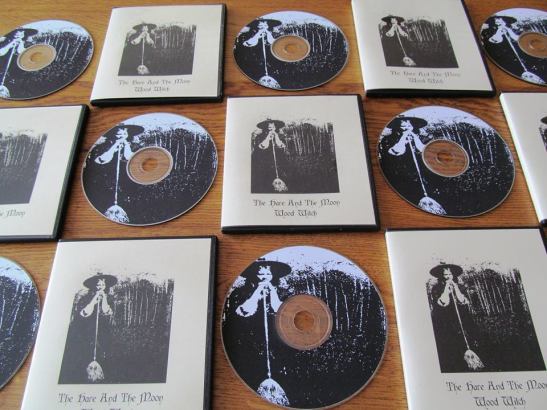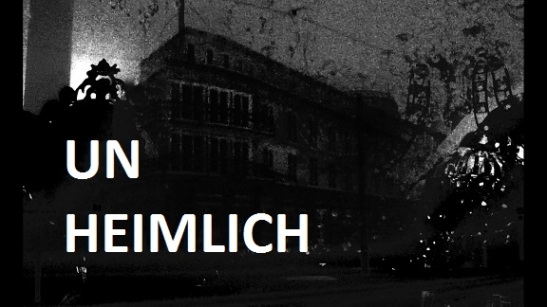Unheimlich Folk: The Hare And The Moon – Wood Witch (Reverb Worship) album review
You step into the dusty parlour of the heritage museum, of the little nowhere town – a tiny silver bell tinkling over the creaking wooden door. The timbers groan beneath your feet, as you place your face next to dusty reliquaries, full of road maps and over-sized balls of yarn; corncob poppets and the phases of the moon. There’s a book, upon a stand – a distant thudding in the distance – opening to contain spiral galaxies and horseshoe nebulae. You fall into it, as in a dream…
Folk music, in its essence, is like sonic recombinant DNA, running through our veins like saltwater, rife for reinterpretation. It’s a crude golem putty, to be cast into strange shambling halflife, from the devilpact Delta blues, to blue-eyed Appalachian lament, to Balkan forelore, to the misty isles of Albion. It almost doesn’t matter what country you grew up in, there’s a distant, irresistible call to traditional music, as if you’ve heard it somewhere before…
It is this uncanny reminiscence that sets the scene, to warp the floors beneath your feet, to pull out the rug, as the old songs you’ve known so long are warped and mutated into unrecognizable sculptures. It DOES something to yr mind. It does something to the way we imagine the past, the stories we tell.

There’s been much talk, these past few years, of the re-emergent spectre of folk horror, conjuring images of linen clad Hammer youths cavorting in the fields, worshiping the megaliths, maybe a scant blood sacrifice or two. It’s wyrd, to be sure, but not exactly a revelation at this point.
But what does it say when pagan madrigals are carved from basalt, and dipped in echo, singing old tales of creatures that never were.
You see, these are folk songs from the land that was never was, a spectral United Kingdoms, issued forth from the magician’s paws of The Hare And The Moon‘s Grey Malkin, on this crowning achievement, five years in the toil, on the legendary Reverb Worship.
It begins with the cawing of crows, the distant, mournful, plaintiff refrain from a bassoon. Right away, the stage is set, with the twittering of birds. Folk music is often associated with place, rooted in the soil. Back in the day when time and geography still existed, this was no problem (although rife for exploitation). This space, this ritualistic circle cast, is no-place, or a country in yr mind. A woman’s voice enters, and begins the incantation, calling the corners, invoking the mood – pure British pastoralism, lovingly ensconced in reverb.
It is this reverb that is the first, and one of the most interesting aspect, of the presentation of this music. It’s HUGE – cathedral massive! And not cheapy digital reverb, either – truly monolithic dimensions, transporting the listener to another realm. Sonically, it reminds me of recent productions from Raime, Emptyset, The Haxan Cloak, and The Stranger, all of which seem to evoke imaginary geographies – places that do not, have never existed. Continents of the mind. The ruins of imagination.
In these ruins, The Hare begins to silhouette against the moon, and it all starts to swim into focus.
On The Wood Witch, Grey Malkin got some of the finest talents into pagan/industrial/magickal folk, from Aine O’ Dwyer, to Tony Wakeford. There are any number of sorceresses, so I’m not really sure who’s who, but the unadorned female vocals tend to hover somewhere between the industrial scrape of The Cranes’ Alison Shaw and more traditional (albeit very, very strange at times) fare like Pentangle and The Incredible String Band, the ol’ freak folk fare.
If I were to shoehorn this, and create a new genre (and lord knows i am guilty of that, at times, but this will not be one of them), you could call it industrial acid folk, perhaps. But you might want to put ‘dream’ in there somewhere, and perhaps a -delia suffix, somewhere, somehow.
The industrial bit, however, comes from a very important reference point – the looming spectres of Mssrs. Christopherson and Balance, of whom no conversation about The Hare And The Moon could be comprehensive.
 Coil painted a black light portrait of England’s Dreaming – England’s Hidden Reverse
Coil painted a black light portrait of England’s Dreaming – England’s Hidden Reverse, it’s been known to have been called. It’s a map of the bones of old Britain – a world of faery circles and heroes and evil witches and plagues and dragons and banshees. Coil started life as a straight up death disco headfuck ketamine electronic outfit, but found their way back to the paganism, to the hooded mysteries, to the stone circles and the old chants. Julian Cope had a similar voyage, and let us not forget our elven friend Genesis P-Orridge.
Between them, they overlay psychic/sonic maps of Carroll psychedelia, ’70s kosmische futurism, a dash of Ballardian dystopia, a few centuries of hidden occult history, the alchemical mindscapes of Alan Moore, and the entirety of arch high street fashion, and what we here in the states called The British Invasion, over the somewhat stuffy realm of British heritage festivals.
How to get from mod to odd, in 3 easy steps.
The point of it all, the point I’m getting at, is there is something cracking, gnawing at the skin of reality, just about to break free. The trees will always break through the pavement, and will bear fruit. And we will see things for as they truly are.
I’m talking about the past. I’m talking about the future.
I’m talking about nostalgia. I’m talking about modernism.
Nostalgia is the sweet needle kiss, the good night balm – comfort in troubling and uncertain times. Yet, as a certain secret brotherhood likes to say, we do not wish to shut the door on the past, nor forget it. We simply cannot believe that all that is old is passe (and, thank the elder gods, i don’t hear too many people arguing that point any longer). But we cannot say, just because something is older, it is inherently better. Like, we cannot swallow the partyline that vinyl is mp3 as a reason to dish out 30 bucks for a chunk of wax, just on others say so. Is it better (the answer is yes, most likely yes, but you must also factor in cost, the space it takes up, and difficulty moving).
It’s a look back. It’s a way forward.
The Wood Witch is a good sonic illustration of this current. Back in the early 2000s, as we were beginning to get jaded and burned out by the ubiquity of both electronic music and electronics in our daily lives, the 19th folk revival took place, and with it, the most recent folk/electronica hybrid, ‘folktronica’.
Like most fledgling attempts at blending computers and reality, folktronica has not aged well, sounding tacky and dated, to these ears. It’s like some kid in their early 20s got a hold of a wheelbarrow full of looper pedals, and set them on funny. It’s like chilean beats on top of Russian peasant chants, in a Balinese gamelan tuning. And the productions sound so full, full to bursting, nearly tumorous with digital life.
It wouldn’t be for another couple of years until people really seemed to be actually melding analogs and electronics, tastefully. This melding is one of the central themes this blog seeks to investigate.
The Wood Witch, in comparison, is elegant, restrained, sparse – nearly skeletal, frequently only one or two instruments at a time. It is predominantly built on a frame of common traditional instruments – piano, harp, and huge, booming drums – plus the occasional burning, distorted electric guitar. The acoustic elements are then lovingly painted in impressionistic studio effects, not digital manipulations, just weird, half-buried incidental artifacts, and luscious 4AD echo and reverb.
And the songs? Because these are songs, make no mistake of it – this is no bleary, smeary drone soundscape. “The Midnight Folk” is a plaintiff soprano prayer in a cornfield, in the solitude of night. “The Bard Of Eve” is a ghostly, mournful congregation, until the old gods return, and the spiral dance begins. “The Bard Of Eve” would actually appeal to fans of traditional celtic or British musick – there’s nothing weirded out about it.
“Come Unto The Corn” is the first keystone, with its iconic Blood On Satan’s Claw “Hail Behemoth…” vocal sample; crawling creepy fifes, turning into a ’70s supernatural horror piano refrain, and those Cranes’ vocals i was talking about. If ever you wanted to know where to get into The Hare And The Moon, this would be it.
“Reynardine”‘s ghostly, mourning synthesized strings underpin a forlorn folk ballad about a rogue a young woman meets upon the road one night, who turns out to be a werefox.
From here on out, The Wood Witch mostly vacillates between unadorned acapellas, albeit lovingly swathed in cocoons of reverb, and instrumentals – some rather unprocessed, as in the piano ballad of “The Wife Of Usher’s Well”, to deep space ambiance, like “The Erl King”, with its ghostly synthetic groaning, that could be the forestpunk national anthem.
I’ve watched these songs materialized in the moonlight, over the past 2 or 3 years, so it is a delight to hear them all together, and delivered in such glorious fidelity and loving presentation. Reverb Worship has outdone themselves, as ever.
I would also like to take a moment, and apologize for my absence. It may seem that i’ve been slacking, but quite the opposite. I’ve been in the forest, in the wilderness, clearing my head of expectations and pressures, getting to the inky spirit of Forestpunk. We believe in music, and believe it to be important (the most important, actually), and i, personally, don’t believe music stops being relevant 2 days after it’s been released.
Forestpunk has always been ABOUT something. I’ve been driving towards a rough half-dozen points or so, this entire time, weaving a tangled skein narrative. It’s about magick, and spirit, and madness, and music. It’s about the past. It’s about the future. It’s about right fucking now. It’s about living in a better world than the one we are currently living in.
I have a vision, where we can live in a world of our choosing. That our dreams can come true. That a balance can be achieved. That you don’t have to be folk or sci-fi, but a little bit of both.
The Hare And The Moon are a little bit folk, a little bit SF – a little bit horror, a little bit occult. A bit experimental, a bit accessible. Damn damn damn good musicians and artists, though.
The Hare And The Moon @ Reverb Worship:
The Hare And The Moon Facebook
The Hare And The Moon Soundcloud

